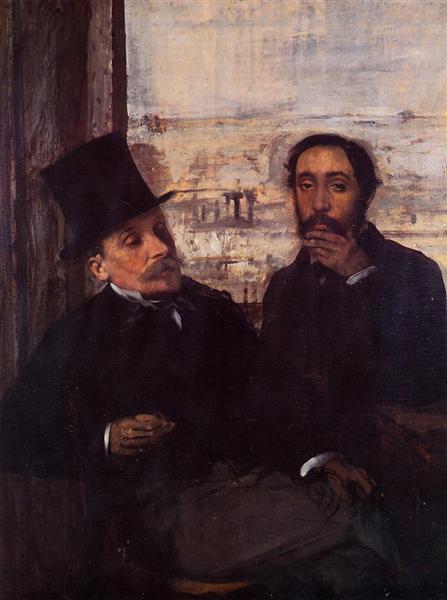Beskrivelse
In Self-Portrait with Évariste de Valernes (1865), Edgar Degas offers a deep and personal insight into the connection between the artist and artistic creation, framing his own image in a context of intellectual camaraderie. In this work, Degas portrays himself alongside Évariste de Valernes, a friend and contemporary artist, suggesting not only a personal relationship, but also an exchange of ideas that enriches the dialogue between them. The way in which Degas places himself next to Valernes, almost in a position of complicity, invites the viewer to consider the mutual influence that existed between the artists of their time.
The composition of the work is remarkable. Degas opts for a dark background that serves to highlight the figures of the portrayed. This use of color establishes a marked contrast with the luminosity of their skin, an element that reinforces the tangible presence of both men in the foreground. The use of shadows and lights reveals the artist's technical skill in capturing the three-dimensionality of forms, a characteristic often found in his work. Degas' direct gaze is penetrating and self-critical; his expression, serene but intense, reflects the contemplation that permeates the act of self-virtuosity, a recurring theme in his work.
The colours used are predominantly earthy, with shades of brown and tones evoking an atmosphere of introspection, while Valernes' darker dress contrasts with the lighter shades of Degas' portrait. The colour palette suggests a harmonisation between the two characters, while inviting the viewer to explore the relationship between the artist and his emotional environment.
Valernes' inclusion is not merely anecdotal; his presence underscores the collaborative aspect of art-making in 19th-century Paris, where friendships and serious discussions about art were central to the evolution of the Impressionist style. Degas, known for his innovative approach to movement and the capture of urban life, applies these same ideas to his own reflection in the self-portrait, where elements of everyday life are intertwined with his self-representation.
This work, though less well-known than some of Degas's larger compositions, offers an intimate look into his personal and professional world. It shares a similar contemplative quality with other self-portraits by artists of the period, in which introspection and self-criticism often play a predominant role. His signature style, which combines classical techniques with a modern approach, distances itself from conventions and instead unites tradition with the exploration of new forms of expression.
Degas portrays not only a friend, but a moment in art history, where dialogue between artists was as fundamental as the paintings they produced. In this painting, we are reminded that artistic creation does not occur in a vacuum, but in the vibrant context of collaboration and friendship. Thus, "Self-Portrait with Évariste de Valernes" becomes not only a testimony to a personal relationship, but a reflection of the spirit of art in a time of change.
KUADROS ©, a famous painting on your wall.
Hand-made oil painting reproductions, with the quality of professional artists and the distinctive seal of KUADROS ©.
Painting reproduction service with satisfaction guarantee. If you are not completely satisfied with the replica of your painting, we will refund 100% of your money.

